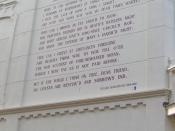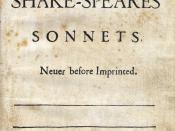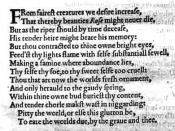Matthew Valiollahi March 13, 2002 English III Research Paper A Critical Analysis of Shakespearean Sonnets In sonnets 130 and 132 by William Shakespeare, they are both similar in the fact that they are both addressed to a beautiful lady but the themes of the lady are conveyed in very different ways. Shakespeare's sonnet 130 he says the lady is ugly but he still thinks she is beautiful in her own way. While in sonnet 132, Shakespeare brings a new life to the women to make the sonnet sound more impressive. Both these Shakespearean sonnets follow the same rhyme scheme. They both have a structure consisting of three quatrains, which are closed off with a rhyming couplet.
In sonnet 130 Shakespeare has a different style in his sonnet, he shows this by completing a statement in one line instead of using a normal two or more lines for the first quatrain.
Examples of these statements are in the first and second line of the sonnet, "My mistress'; eyes are nothing like the sun;" (Booth, 37) In this sentence Shakespeare seems to be mocking the girl by saying that the eyes of his mistress do not resemble the sun at all. He then goes on to say, "Coral is far more red than her lips red;" (Jones, 132) This sentence states a different feature of his mistress' qualities.
Shakespeare continues to describe his mistress breasts and hair in the next two lines. The second quatrain starts with line five, in this quatrain, Shakespeare no longer writes with a complete statement in one line. He seems to relax, and develops his comparisons. This means that two lines are now used to make a unit of sense. Shakespeare has used the next two quatrains to describe her cheeks, breath, voice and walk.
Then, in the Shakespearean sonnet 132, the first two quatrains seem to be about the same thoughts, "Thine eyes I love" (Senna, 118). The third quatrain is linked to the previous two quatrains as he is still trying to express how she should love him back with her heart. The ninth line of the sonnet seems to be an extended line of the second quatrain as it does not fit in with the last quatrain. This probably was because Shakespeare had not completed his descriptions of her two dark mourning eyes that are more glorious than the bright stars. This was the only unusual feature of Shakespeare's sonnet structure in this sonnet.
Sonnet 130 shows that Shakespeare is taking an idealistic approach towards this sonnet. He shows that he truly loves his mistress, even though she does not have hair like golden wires and eyes like suns. He writes that his mistress "treads on the ground'" (Best, 3/10/02) rather than drifts through the air, like a traditional Shakespearean sonnet describes. He also writes that her; breasts are dun; and that black wires grow on her head.
However, although he writes about all these negative points, the problem is solved in the end when he writes in the couplet, "I think my love is rare As any she belied with false compare." (Booth, 37) This means that he does not care that she does not conform to be like the common woman with roses in her cheeks and a voice like music. He thinks that she is just as beautiful, or even more beautiful, than all those women that have been written about in sonnets from other sonneteers.
In sonnet 132, Shakespeare takes on the voice of the original lover who is in anguish and pain because his unrequited love rejects him. Her eyes are mourning for him, knowing that her; heart torments; him. Shakespeare is describing how her eyes are separate from her and think differently from the rest of her body, especially her heart. Shakespeare expresses himself by saying that her dark eyes make her whole face beautiful, like the mourning sun of heaven. He is using homophones such as mourning to represent the morning. Shakespeare writes that if her mourning eyes make herself beautiful, then "let it as well beseem thy heart" (Jones, 132) let her heart mourn for him too and this would make her even more beautiful.
He is pleading her to give herself to him. Shakespeare finishes this sonnet, by writing that, if you give yourself to me, then all those that are not beautiful are those that would lack your complexion.
Shakespeare used different tones in each sonnet. There was a blunt and assertive tone in sonnet 130, where he is denying the validity of extraordinary comparisons by rejecting all the usual common rhetorical devices and conceits as they show a false idealized beauty. Shakespeare is using paradox against itself, this was probably seen as negative at the time that it was written. I believe that Shakespeare thought that the original common cliches of his time were no longer impressive, and decided to write a sonnet that gave a new life to the ordinary cliches to become more impressive when writing sonnet 132.
Shakespeare uses personification in this sonnet, and describes her eyes as if they, itself were humans. He writes about impossible paradox comparisons as he is trying to be impressive and witty. Shakespeare develops the original ideas for his time and seems to be breaking the mold with these two sonnets.





